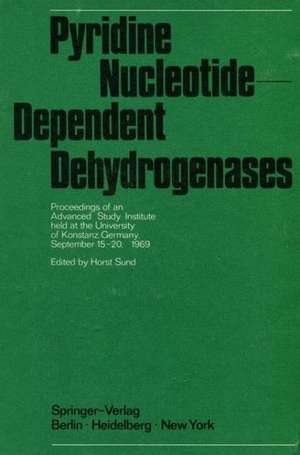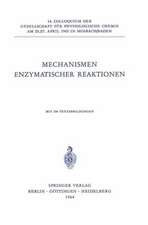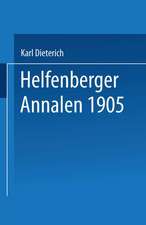Pyridine Nucleotide-Dependent Dehydrogenases: Proceedings of an Advanced Study Institute held at the University of Konstanz, Germany, September 15–20, 1969
Editat de Horst Sunden Limba Engleză Paperback – iun 2012
Preț: 732.92 lei
Preț vechi: 771.50 lei
-5% Nou
Puncte Express: 1099
Preț estimativ în valută:
140.24€ • 146.44$ • 115.81£
140.24€ • 146.44$ • 115.81£
Carte tipărită la comandă
Livrare economică 15-29 aprilie
Preluare comenzi: 021 569.72.76
Specificații
ISBN-13: 9783642499760
ISBN-10: 3642499767
Pagini: 492
Ilustrații: XV, 472 p.
Dimensiuni: 178 x 254 x 26 mm
Greutate: 0.84 kg
Ediția:Softcover reprint of the original 1st ed. 1970
Editura: Springer Berlin, Heidelberg
Colecția Springer
Locul publicării:Berlin, Heidelberg, Germany
ISBN-10: 3642499767
Pagini: 492
Ilustrații: XV, 472 p.
Dimensiuni: 178 x 254 x 26 mm
Greutate: 0.84 kg
Ediția:Softcover reprint of the original 1st ed. 1970
Editura: Springer Berlin, Heidelberg
Colecția Springer
Locul publicării:Berlin, Heidelberg, Germany
Public țintă
ResearchDescriere
The present volume represents the proceedings of the symposium on npyridine Nucleotide-Dependent Dehydrogenases" which was held on the campus of the re cently established University of Konstanz, Germany, from September 15 to 20, 1969. The aim of the symposium was to provide a forum for discussion among the experts interested in the various aspects of pyridine nucleotide-dependent de hydrogenases and the pyridine coenzymes, so as to evaluate the state of the present knowledge and to stimulate further progress in this field. In order to facilitate discussion and personal contact it was necessary to restrict the number of participants to 90 including the invited speakers, who came from fifteen countries (Australia, Austria, Denmark, England, Finland, France, Germany, Hungary, Israel, Italy, Japan, Netherlands, Sweden, Switzerland, USA). The printed lectures in this volume differ only in minor respects from those circulated be fore the meeting. In some cases speakers presented new experimen tal material during the symposium which was added as an addendum to the papers. The discussions were not recorded. The participants were requested to provide a written report of what they considered worth including in the published re port. This, together with the answers of the speakers is presented in this vo lume. I whish to thank all the speakers and discussants for their cooperativity in preparing the manuscript. The symposium was sponsored by the International Union of Biochemistry whose President, Professor Theorell, was also present and who was acting as one of the speakers and chairmen.
Cuprins
Opening Remarks.- Section I General.- Kinetics.- The Mechanism of Hydride Transfer.- Discussion.- The Significance of the Investigation of Model Compounds for the Elucidation of the Mechanism of Hydrogen-Transfer with Pyridine Nucleotides.- Discussion.- The Structure of Pyridine Coenzymes as Related to Binding.- Discussion.- Section II Structure and Function of Dehydrogenases.- The Primary Structure and Activity of Glyceraldehyde 3-Phosphate Dehydrogenase.- Discussion.- Quaternary Structure and Conformation of Lactic Dehydrogenase and Glyceraldehyde-3-Phosphate Dehydrogenase.- Discussion.- The Stereoselective Inhibition of Functional — SH Groups of Dehydrogenases.- Discussion.- The Role of Zinc Ions, — SH Groups, and Histidyl Residues in the Mechanism of Dehydrogenases.- Section III Alcohol and Lactate Dehydrogenases.- Structural and Functional Relationships between Isoenzymes of Horse LADH.- Discussion.- X-Ray Studies of Horse Liver Alcohol Dehydrogenase.- Discussion.- Lactate Dehydrogenase.- Discussion.- Studies on Structure and Active Sites of Lactate Dehydrogenase from Pig Heart and Pig Muscle.- Discussion.- Structure and Mechanism of Lactate Dehydrogenase.- Discussion.- Section IV Glyceraldehyde-3-Phosphate Dehydrogenases.- Selective Reactivity of Functional Groups in Glyceraldehyde 3-Phosphate Dehydrogenase.- Discussion.- On the Relationship between Protein Conformation and Enzyme-Substrate Covalent Bond Formation in Glyceraldehyde-3-Phosphate Dehydrogenase.- Discussion.- Cooperative Phenomena in Yeast Glyceraldehyde-3-Phosphate Dehydrogenase.- Discussion.- Conformational Effects of NAD+ on Yeast Glyceraldehyde-3-Phosphate Dehydrogenase.- Discussion.- Recent Studies on the Allosteric Glyceraldehyde-3-Phosphate Dehydrogenase from Yeast.- Discussion.- Subunit Interactions in Glyceraldehyde-3-Phosphate Dehydrogenase: A Fluorometric and Calorimetric Analysis of DPN Binding as a Function of Temperature.- Discussion.- Muscle Glyceraldehydephosphate Dehydrogenase: NAD+ Binding and its Implications for the Mechanism of Action of the Enzyme.- Discussion.- Section V Glutamate Dehydrogenases.- Kinetics and Mechanism of Glutamate Dehydrogenase.- Discussion.- Optical Probes for Glutamate Dehydrogenase.- Discussion.- Glutamate Dehydrogenase — A Study on its Inactivation.- Discussion.- Quaternary Structure and Enzymic Properties of Beef Liver Glutamate Dehydrogenase.- Discussion.- Structure and Association of Glutamate Dehydrogenase Solutions.- Discussion.- Mechanism of Action of Glutamate Dehydrogenase from Various Sources.- Discussion.- Section VI Different Aspects of Reactions Catalyzed by Dehydrogenases.- Kinetic Studies of NADP-Dependent Isocitrate Dehydrogenase from Beef Heart Mitochondria.- Discussion.- The Role of NAD-Linked Dehydrogenases in the Biosynthesis of UDP-D-Xylose.- Discussion.- Regulation by NADP+ and NADPH of Transhydrogenase from Azotobacter Vinelandii.- Activation Effect of 2?-Adenylic Acid on Bacterial Transhydrogenases.- Combined discussion on papers.- Section VII Pyridine Nucleotide-Dependent Flavin Enzymes.- The Role of NAD+ in the Catalytic Mechanism of Lipoamide Dehydrogenase.- Discussion.- The NADH Dehydrogenase of the Respiratory Chain.- Discussion.- A New Intermediate in TPNH-Linked Flavoproteins.- Discussion.- Section VIII Metabolic Aspects.- Regulation of the Redox State of the Pyridine Nucleotides in Rat Liver.- Discussion.- The State of the DPN System in Liver. An Analysis of Pyridine Nucleotide Levels, Surface Fluorescence, and Redox Potentials of Indicator Metabolite Couples in the Hemoglobin-Free Perfused Rat Liver.- Closing Remarks.- Index of Contributors.



![Transport by proteins: proceedings of a symposium held at the University of Konstanz, West Germany, July 9 - 15, 1978 ;[Symposium on Transport by Proteins]](https://i4.books-express.ro/bt/9783110076943/transport-by-proteins.jpg)






















